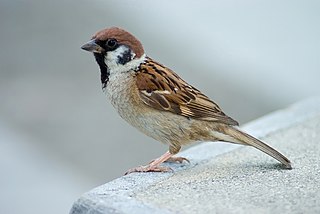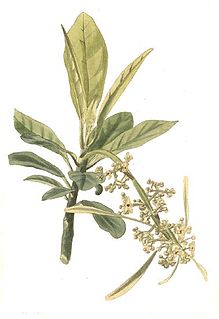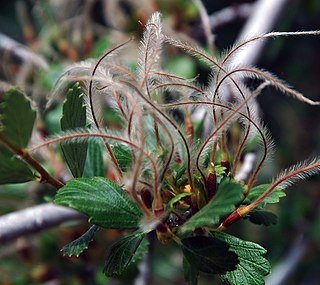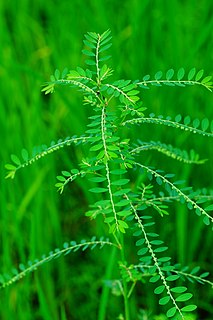
The Eurasian tree sparrow is a passerine bird in the sparrow family with a rich chestnut crown and nape, and a black patch on each pure white cheek. The sexes are similarly plumaged, and young birds are a duller version of the adult. This sparrow breeds over most of temperate Eurasia and Southeast Asia, where it is known as the tree sparrow, and it has been introduced elsewhere including the United States, where it is known as the Eurasian tree sparrow or German sparrow to differentiate it from the native unrelated American tree sparrow. Although several subspecies are recognised, the appearance of this bird varies little across its extensive range.

Phyllanthus is the largest genus in the flowering plant family Phyllanthaceae. Estimates of the number of species in this genus vary widely, from 750 to 1200. Phyllanthus has a remarkable diversity of growth forms including annual and perennial herbs, shrubs, climbers, floating aquatics, and pachycaulous succulents. Some have flattened leaflike stems called cladodes. It has a wide variety of floral morphologies and chromosome numbers and has one of the widest range of pollen types of any seed plant genus.

Phyllanthaceae is a family of flowering plants in the eudicot order Malpighiales. It is most closely related to the family Picrodendraceae.

Phyllanthus emblica, also known as emblic, emblic myrobalan, myrobalan, Indian gooseberry, Malacca tree, or amla from Sanskrit amalaki is a deciduous tree of the family Phyllanthaceae. It has edible fruit, referred to by the same name.

Omphalea is a plant genus of the family Euphorbiaceae first described as a genus in 1759. It is native to tropical parts of the Americas, the West Indies, Asia, Australia, and Africa.

Bridelia is a plant genus of the family Phyllanthaceae first described as a genus in 1806. It is widespread across Africa, Australia, southern Asia, and various islands of the Indian and Pacific Oceans.
The mountain noctule is a species of bat found in Afghanistan, India, Pakistan, and Nepal.

The small big-eared brown bat is a species of vesper bat in the family Vespertilionidae. It can be found in the following countries: Argentina, Bolivia, Brazil, Chile, Colombia, Ecuador, Peru, Uruguay, and Venezuela.

The montane vole is a species of vole native to the western United States and Canada.
The Nillu rat or Sri Lankan mountain rat is a species of rodent in the family Muridae. It is found only in Sri Lanka where it is known as நில்ளு எலி in Tamil and නෙලූ මීයා(Nelu Meeya) in Sinhalese.

The montane racket-tail or the Luzon racket-tail, is a species of parrot in the family Psittaculidae. It is endemic to northern Luzon in the Philippines.

The Asian highland shrew is a species of mammal in the family Soricidae. It is found in India and Sri Lanka. Its habitat is subtropical or tropical dry forests. It is threatened by habitat loss. It is known as ශ්රී ලංකා කදු හික් මීයා in Sinhala.
Montanus is a Latin word meaning mountain.
Phyllanthus pavonianus, synonym Phyllanthus haughtii, is a species of plant in the family Phyllanthaceae. It is native from south Ecuador to north-west Peru. Its natural habitat is subtropical or tropical moist montane forests. Under the synonym Phyllanthus haughtii, it has been regarded as "endangered".
The Sumatran Muntjac is a subspecies of Indian muntjac in the deer family which can be the size of a large dog. It was discovered in 1914, but had not been sighted since 1930 until one was snared and freed from a hunter's snare in Kerinci Seblat National Park, Sumatra, Indonesia in 2002. Two other Sumatran muntjac have since been photographed in the park. The Sumatran Muntjac was placed on the IUCN Red List in 2008, but was listed as Data Deficient, as taxonomical issues are still unresolved. The distribution of the species is also uncertain and may be more extensive than suggested. It is possible that some previous sightings of the common muntjac in Western Sumatra were the Sumatran muntjac.

Cercocarpus montanus is a North American species of shrub or small tree in the family Rosaceae native to northern Mexico and the western United States. It is known by the common names alder-leaf mountain-mahogany, alder-leaf cercocarpus, and true mountain-mahogany. The variety argenteus is commonly known as silverleaf mountain-mahogany.

Phyllanthus niruri is a widespread tropical plant commonly found in coastal areas, known by the common names gale of the wind, stonebreaker or seed-under-leaf. It is a relative of the spurges, belonging to the genus Phyllanthus of the family Phyllanthaceae.

The Timorese horseshoe bat is a species of bat native to Timor-Leste.

Phyllanthus reticulatus is a plant species described Jean Louis Marie Poiret; it is included in the family Phyllanthaceae.














